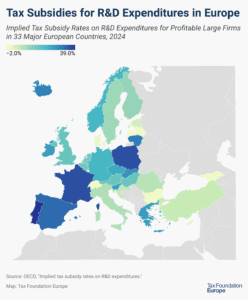
Tax Avoidance Rules Increase the Compliance Burden in EU Member Countries
7 min readBy: ,The question of how to address base erosion and profit shiftingProfit shifting is when multinational companies reduce their tax burden by moving the location of their profits from high-tax countries to low-tax jurisdictions and tax havens. has been a growing concern in recent years. It gained force around the world when the OECD published recommendations from the Base Erosion and Profit Shifting (BEPS) project in 2015. European countries face many issues that the BEPS project was intended to address. In fact, the challenges in Europe may be exacerbated due to the existence of the European Union (EU) and the single market. In this context, it may have been easier for any multinational corporation based in the EU to plan around member countries’ legislation to minimize its taxA tax is a mandatory payment or charge collected by local, state, and national governments from individuals or businesses to cover the costs of general government services, goods, and activities. burden.
The EU internal market consists of a single market made up of the current 28 member countries where each country allows the free movement of goods, services, capital, and persons. With all those freedoms in a single market (including the freedom of establishment), there are ongoing concerns in the EU Council about tax avoidance by multinational businesses and its impact on the tax revenues of its members.
In June 2016, the EU Finance Ministers reached an agreement to lay down a common set of rules against tax avoidance practices that affect the functioning of the internal market. The project was named Anti Tax Avoidance Directive (ATAD). The ATAD policies were to be implemented by all member states no later than January 2019.
ATAD is a set of minimum standards based on the work made by the OECD on the BEPS project. The standards include interest deductibility limitations, controlled foreign corporations’ (CFC) rules, rules to tackle hybrid mismatches, measures on exit taxation, and a general anti-abuse rule (GAAR). The purpose of the rules was to level the playing field in the single market and create a business environment with fair conditions for all EU members.
With the incorporation of the rules, some EU members will lose the competitive advantages in attracting business investment that they gained prior to ATAD. Therefore, those countries could now appear less attractive to businesses in other EU countries. On the other hand, businesses that already have corporate structures in place across the EU will face additional layers of complexity from the compliance perspective, increasing the amount of compliance hours and the costs that the changes on the systems of different countries imply for them.
While minimizing tax avoidance may be an appropriate policy goal, it is important that policymakers recognize the trade-offs with higher compliance costs and increased tax burdens on cross-border trade and investment due to ATAD.
Though most EU countries have implemented each piece of ATAD, several countries are in various stages of implementing the rules.
Exit taxation rules
The rules on exit taxation are intended to prevent taxpayers from avoiding tax by transferring assets, permanent establishments, or moving their tax residences out of a member state’s taxing jurisdiction. This is done by taxing the excess of the market value of the transferred assets over their tax value.
In the case of exit tax rules, 17 out of 28 members now have exit taxes. The ATAD deadline for incorporating the rules is the end of 2020. Cyprus, Czech Republic, Denmark, Croatia, and Malta are discussing legislative proposals to incorporate the rules. Other countries including Bulgaria, Greece, Hungary, Latvia, Slovenia, and Lithuania do not currently have a set of rules and will need to adopt them through their legislation.
Denmark has exit tax rules that are applicable to individuals but not to corporations. A legislative proposal to enact corporate exit tax rules by 2020 is being discussed. Finland already has an exit tax, but it needs to be modified in order to comply with ATAD standards. Sweden has a rule to tax capital gains 10 years after a resident leaves the country. However, the Swedish government does not want to replace the 10-year rule with an exit tax.
CFC rules
CFC rules aim to eradicate the incentive that many multinationals have to shift taxable incomeTaxable income is the amount of income subject to tax, after deductions and exemptions. For both individuals and corporations, taxable income differs from—and is less than—gross income. to a subsidiary in a low-tax jurisdiction where the company does not have any genuine economic activity according to EU standards.
CFC rules are not new for many EU members. Some current member states had CFC rules in place in the 1970s and have been working to improve them through the years. Currently 27 out of 28 EU member states have CFC rules. Cyprus is the only EU member country that does not have the rules and will need to adopt them this year.
Hybrid Mismatch Rules
Hybrid mismatch rules are intended to prevent double deductions or deductions without the corresponding inclusions by addressing mismatches between member states’ tax bases. The variation among EU member countries in definitions of taxable income allows some businesses to minimize their tax burden by taking advantage of various differences.
As of March 2019, 22 out of 28 countries have a formal set of hybrid mismatch rules. Romania is in the process of implementing the rules, and the Czech Republic will conclude implementation of its rules by 2020.
The General Anti-avoidance Rule (GAAR)
The GAAR allows tax authorities to look at business arrangements and determine whether the primary purpose of those arrangements is to gain an unintended tax advantage. These are generally arrangements that do not reflect economic reality or that do not have valid commercial reasons.
Currently, 26 out of 28 EU members have a GAAR in place, though the Czech Republic and Latvia do not have a specific set of similar rules.
Interest Deductibility Rules
The purpose of rules that limit deductible interest is to discourage companies located in various EU countries to reduce their taxable income by inflating borrowing among various business entities. Because interest is generally a deductible expense, some companies arrange financing structures between entities so that interest income is booked in a low-tax jurisdiction while interest expenses are booked in higher tax jurisdictions. The rules limit deductible borrowing costs by establishing a threshold in a set amount (above which interest is not deductible) or a percentage of the taxpayer’s earnings before interest, taxes, depreciationDepreciation is a measurement of the “useful life” of a business asset, such as machinery or a factory, to determine the multiyear period over which the cost of that asset can be deducted from taxable income. Instead of allowing businesses to deduct the cost of investments immediately (i.e., full expensing), depreciation requires deductions to be taken over time, reducing their value and discouraging investment. , and amortization (EBIDTA).
Twenty-five out of 28 current EU members have one or more rules limiting interest deductibility. Austria has implemented a similar rule; however, the EU did not include Austria in the list of countries that have correctly implemented ATAD measures. Because of this, Austria may take further action to follow the EU standard. Ireland also does not have a specific interest deduction limitation rule. Cyprus will incorporate the rules by 2020.
Countries including Germany, the United Kingdom, and France did not make any major changes to their legislation to comply with ATAD. In other cases, countries including the Netherlands, Ireland, Cyprus, and Luxemburg incorporated ATAD suggestions into their legislation for the first time.
|
Source: Deloitte tax guides and highlights 2018, 2019. PwC Worldwide Tax Summaries 2018/2019. |
|||||
| Country | CFC rules | Interest limitation | Hybrids mismatches | Exit taxation | GAAR |
|---|---|---|---|---|---|
| Austria | Yes | No | Yes | Yes | Yes |
| Belgium | Yes | Yes | Yes | Yes | Yes |
| Bulgaria | Yes | Yes | No | No | Yes |
| Croatia | Yes | Yes | No | by 2020 | Yes |
| Cyprus | by Dec. 2019 | by 2020 | Yes | by 2020 | Yes |
| Czech Republic | Yes | Yes | by 2020 | by 2020 | No |
| Denmark | Yes | Yes | Yes | by 2020 | Yes |
| Estonia | Yes | Yes | Yes | Yes | Yes |
| Finland | Yes | Yes | Yes | Yes | Yes |
| France | Yes | Yes | Yes | Yes | Yes |
| Germany | Yes | Yes | Yes | Yes | Yes |
| Greece | Yes | Yes | Yes | No | Yes |
| Hungary | Yes | Yes | Yes | No | Yes |
| Ireland | Yes | No | No | Yes | Yes |
| Italy | Yes | Yes | Yes | Yes | Yes |
| Latvia | Yes | Yes | Yes | No | No |
| Lithuania | Yes | Yes | No | No | Yes |
| Luxembourg | Yes | Yes | Yes | Yes | Yes |
| Malta | Yes | Yes | Yes | by 2020 | Yes |
| Netherlands | Yes | Yes | Yes | Yes | Yes |
| Poland | Yes | Yes | Yes | Yes | Yes |
| Portugal | Yes | Yes | Yes | Yes | Yes |
| Romania | Yes | Yes | by Dec. 2019 | Yes | Yes |
| Slovakia | Yes | Yes | Yes | Yes | Yes |
| Slovenia | Yes | Yes | Yes | No | Yes |
| Spain | Yes | Yes | Yes | Yes | Yes |
| Sweden | Yes | Yes | Yes | Yes | Yes |
| United Kingdom | Yes | Yes | Yes | Yes | Yes |
Conclusion
Even though ATAD sets out minimum standards for rules, each member state has the ability to enact different legislative approaches. The EU Council expects that tax planning opportunities in the EU will be reduced once all member states have implemented the rules. There will be immediate economic effects because of the enactment of the rules. The higher compliance burden will also affect multinational companies that operate in the EU.
Share this article




